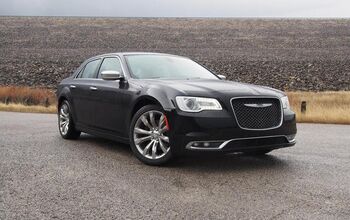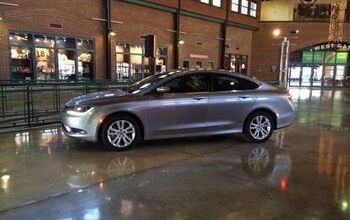Capsule Review: 1967 Chrysler Imperial

I signaled to the engine room to increase power as I hefted the helm over to full starboard to clear the iceberg curb. Just like the ill-fated Titanic, I failed; however, unlike the ill-fated luxury liner, my interstate bound ship of dreams shrugged off the concrete obstacle with only a slight disturbance of the ever present floating waft. Never had I piloted a vehicle so large and vast feeling as my Avocado Green Metallic 1967 Imperial, made by Chrysler. At 224in long, and over 5600lbs of pure American uni-bodied steel, puts the similar sized Hummer H2 to shame in its ability to show of its largess. At least the Hummer has a modicum of efficient design, not so the Imperial, one of the shining examples of the de facto “Detroit Schoolhouse of Design.”
Back then, just like now, Chrysler trailed the offerings from the other two large American automakers. It didn’t have the cache, build quality, nor sales numbers enjoyed by Cadillac and Lincoln. It didn’t matter that in 1955 Chrysler spun off the Imperial into its own brand in an attempt to persuade wealthy bankers of Dallas to part with their money. However, unlike today, the interior fittings were still stunning in their execution, especially to a teenager of the 1990’s who grew up with European sports sedans before they embraced high quality plastics. The dashboard stretched so far out to the horizon that the air vents grew hazy in the distance. Toggle switches complemented chrome plated wheels to lend an air of sophistication to someone used to the click-n-crunch buttons of a Chrysler LeBaron. If you could tear your eyes away from the tape-measure style speedo, you would find the turn-signal indicator placed way out on the front fender tips; cool, but not functional when you could barely see them in the daylight.
But who cared? This car was built for ultimate cruising, right down to the bench seats covered in leather dyed in such hideous shades it would make Baby Jesus cry. The 440 V-8 pushed out an impressive 350bhp and 480ftlbs of torque, and returned a miserable 12mpg overall. While that sounds impressive, it really wasn’t as the 0-60 times of 10 seconds are matched by a modern Prius. What the Prius doesn’t match is the ride. Oh to feel the waft of the Imperial, the sheer isolation and solitude of a big lazy car riding on whitewalls stirs nostalgic feelings of a decade I never saw. At least I was able to pretend in the big Imperial in my polyester tuxedo on the way to my Senior Prom.

More by Mike Solowiow
Latest Car Reviews
Read moreLatest Product Reviews
Read moreRecent Comments
- Kwik_Shift_Pro4X Where's the mpg?
- Grg These days, it is not only EVs that could be more affordable. All cars are becoming less affordable.When you look at the complexity of ICE cars vs EVs, you cannot help. but wonder if affordability will flip to EVs?
- Varezhka Maybe the volume was not big enough to really matter anyways, but losing a “passenger car” for a mostly “light truck” line-up should help Subaru with their CAFE numbers too.
- Varezhka For this category my car of choice would be the CX-50. But between the two cars listed I’d select the RAV4 over CR-V. I’ve always preferred NA over small turbos and for hybrids THS’ longer history shows in its refinement.
- AZFelix I would suggest a variation on the 'fcuk, marry, kill' game using 'track, buy, lease' with three similar automotive selections.


































Comments
Join the conversation
I don't know about all the actual technical and engineering details of what makes the 1967 Imperial truely different from other Chryslers, but I just know that Dad's 1965 Chrysler Windsor couldn't hold a candle to his 1967 Imperial Crown four door hardtop. I took my driver's licence test in the Imperial, and I drove it from time to time from 1971 until 1983 when he sold it (still in excellent mechanical condition with absolutely not the slightest hint of rust and all accesories still working perfectly). I have owned and driven modern luxury sport sedans (Acura, Infiniti, etc. over the past decade, and still, I can't compare them with the 1967 Imperial. I remember driving this car from Toronto Canada to Conneticutt in 1974 to visit a fairly new girlfriend, and at 90 MPH it held the road perfectly, and gave 100% confidence in terms of handling and performance. I've driven this car through secondary "twistys" in northern Ontario (the way they were in the late 1970's - not like modern straigthened "safe" mandated roads we have today), pushing the limits of its handling, and for such a big, long, heavy car, I never felt any lack of confidence. And that 440, with the 4 barrel carburetor made that car move when you needed it (maybe some moderm cars would beat it from 0 - 60, but with 480 ft/lbs. of torque and 350 hp, above 70 mph, I would like to see some modern day "buzz bombs" keep up with it from 70 - 125 mph (just try that one and see who lags behind). You have to have actually driven this car to understand what it was like - nothing I have driven since can remotely compare - including the Mercedes C350 I rented in Switzerland back in 1986).
And just to make another point, you cannot compare a mid-1960s car with a some choked off, pollution controlled car from the early 1970s to the early 1980s when the American car manufacturers finally started to learn how to make engines with power that didn't pollute. To the point, my 1980 Pontiac Grand Prix with a 4.3 liter V-8 probably barely made 110 hp (maybe less) and my 1978 Chevrolet Malibu with a 3.3 litre V-6 probably barely made 75 hp. My 1981 Mazda RX-7 made more horsepower than either of them with only about 0.95 litre of displacement in a rotary engine. American cars through most of the 1970s and early 1980s can only be described as "pathetic, asthmatic, losers" with the exception of a few early 1970s muscle cars (and even they got choked off in the mid to late 1970s because Detroit just didn't know how to make a strong engine that didn't pollute).